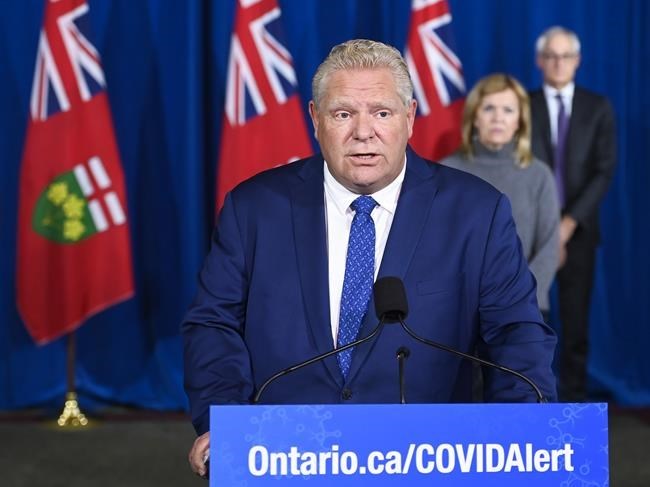
Ontario Premier Doug Ford holds a press conference during the COVID-19 pandemic in Toronto on Friday, Oct. 2, 2020. Ontario Premier Doug Ford has some tough choices to make as he decides which businesses can reopen while the province reports a single-day record in new coronavirus cases. THE CANADIAN PRESS/Nathan Denette
Republished November 03, 2020 - 6:03 PM
Original Publication Date November 03, 2020 - 8:26 AM
OTTAWA - The country's top doctor unveiled new recommendations Tuesday for non-medical masks, saying they should be made of at least three layers and stressing their importance as the country heads indoors for winter amid a surging COVID-19 case count.
Face masks should comprise two layers of tightly woven fabric such as cotton or linen, plus a third layer of a "filter-type fabric" such as polypropylene, according to the Public Health Agency of Canada.
“We’re not necessarily saying throw out everything that you have," Dr. Theresa Tam, Canada's chief public health officer, said at a news conference.
"The fit is the most important thing," she said, emphasizing a nose pinch and full coverage of nose and mouth, but also comfort and breathability.
In a departure from news conference habit, the country's top politicians and doctors wore their masks except when speaking, underscoring the role of face coverage in battling the pandemic as temperatures drop. Ordinarily participants take off their masks once they take their places.
"Because it’s winter, because we’re all going inside, we’re learning more about droplets and aerosols. It’s just another layer of protection," Tam said in Ottawa.
The World Health Organization recommended wearing filtered, three-layer masks as early as June 12, but Tam said face coverings are an area of "evolving science."
The mask memo came as Ontario reported a single-day record of 1,050 new cases of COVID-19 on Tuesday, and 14 new deaths due to the virus.
About 80 per cent of the new cases were in the hot spots of Toronto and the surrounding regions of Peel, Halton, York and Durham.
Alberta reported an average of 567 daily cases over the past four days — "a large and troubling number," said Dr. Deena Hinshaw, the province's chief medical officer of health — and 15 deaths since Friday.
"This is not good news. This is a problem," Hinshaw said of the spike, which marked a 19 per cent increase from new cases reported last Thursday.
Quebec reported an eight-day low of 871 new COVID-19 infections and 34 more deaths attributed to the novel coronavirus.
Over the past month case counts have plateaued in the province, which last week prolonged "red-zone" restrictions until Nov. 23 for 12 of its 19 health regions.
Dr. Horacio Arruda, Quebec's director of public health, said Tam's recommendations "are OK," but added that the province is going further by establishing baseline standards for masks that could require government approval of products.
Masks, physical distancing and partial lockdowns make up some of the main defences against the contagion until the arrival of a vaccine, which Tam hopes will be available in limited supply "as early as possible in 2021."
"The exact timing is really difficult to identify today, because It really all hinges on how the vaccines perform in these critical trials," said Dr. Matthew Tunis, executive secretary to the National Advisory Committee on Immunization.
When vaccines do emerge for distribution, four groups should be prioritized for early immunization, according to the committee: those at high risk of severe illness and death from COVID-19, including Canadians aged 70 and older; those most likely to transmit the virus to high-risk residents, such as health-care workers; essential workers; and people whose living conditions up their risk of catching the disease, including those in Indigenous communities.
Governments have struggled to weigh health priorities against economic woes and pandemic fatigue as uncertainty around vaccines and the prospect of social isolation add a bleaker tint to the onset of winter.
Ontario Premier Doug Ford said he will ease restrictions on the province's hot spots, despite the unprecedented spike in cases and in contrast with Quebec's recent extension of red-zone measures.
Ford rolled out a new tiered system Tuesday for when and to what extent coronavirus restrictions are placed on parts of the province, saying it will help fight the pandemic at a regional level.
The framework goes into effect on Saturday, allowing restrictions in the current hot spots of Ottawa and Peel and York regions to loosen up this weekend, with Toronto added on Nov. 14. The softer rules mean gyms and cinemas can reopen and indoor dining will resume — with capacity limits — following closures under "modified Stage 2" measures imposed Oct. 10.
Saskatchewan, which announced 81 new COVID-19 cases Tuesday, is making masks mandatory in indoor public places in its three biggest cities. The rule comes into effect Friday in Saskatoon, Regina and Prince Albert and is to last at least 28 days.
In his own news conference Tuesday, Conservative Leader Erin O'Toole called for the Liberals to put a pause on federal audits of small businesses hit hard by COVID-19.
He said too many small and medium-sized businesses are struggling to survive during the pandemic, and still have been hit by what he calls unfair audit requests from the Canada Revenue Agency.
Many small businesses, such as restaurants and in the tourism sector have been asking unsuccessfully for months for extra help through the federal wage-subsidy program to keep employees on payrolls, O'Toole said.
As of Tuesday night, 244,935 Canadians have contracted the virus since March and 10,279 people have died.
This report by The Canadian Press was first published Nov. 3, 2020.
—With files from Shawn Jeffords and Jordan Press
News from © The Canadian Press, 2020